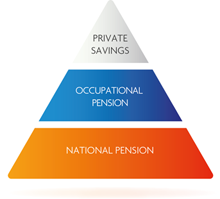Pensions – a general picture

Your pension consists of three main components; the national retirement pension, the occupational pension for government employees which is regulated by the PA 16 Collective Agreement, and any private pension savings you may have undertaken. The latter will not be dealt with in any detail here.
Both the retirement pension and the occupational pension are paid in by the employer when salary payments are made.
National retirement pension
This pension is calculated on your income generally from employment, but also income from unemployment, sickness benefits and activity benefits, parental allowance and education allowance. Scholarships are not pension-generating.
The national pension system has two components: income pension and premium pension. The premium pension, which is the smaller of the two parts, is placed in mutual funds and you have yourself the opportunity to make your fund selection. For more information on this see Fondkollen and the Pension Agency website.
Occupational pension
In order to receive an occupational pension, you must be employed by an employer who has entered into a collective agreement. Only employees are able to earn such pensions. If you have a scholarship you are not an employee and consequently do not generate occupational pension contributions.
State employee
As a state employee, you are covered by the state occupational pension agreement PA16.
Section 1 of the agreement applies to employees who were born in 1988 or later. The state occupational pension consists of three components: the selectable part, Kåpan Tjänste and Kåpan Flex. You can decide how the selectable part of your pension plan will be invested. You earn occupational pension until the age of 69.
Section 2 of the agreement applies to employees were born before 1988. The occupational pension consists of a defined-benefit pension, (if you were born before 1973 or were born later and have a salary above a certain level), Kåpan Tjänste and the selectable component. You can decide how the selectable component will be invested. On 1 January 2024, a new component of the pension plan will be introduced: Kåpan Flex. The premium corresponds to 0.5-1.5 per cent of your salary. In addition, you will earn defined-contribution pension contributions until the age of 69 if you continue to work. (The previous age limit was 65). Employees who were born before 1966 are covered by special transitional rules.
Please note that no changes are being made with regard to earning defined-benefit pension contributions. You can read more about the PA 16 pension agreement here.
Regardless of your date of birth, disability benefits that you receive when you are sick are included in the state employers’ occupational pension. In addition, compensation can be paid to your beneficiaries if you die.
You can find more information on the National Government Employee Pensions Board (SPV) website. The website also shows how much the employer pays in pension contributions each month if you are employed in the state sector (in Swedish).
If you have an individual agreement with your employer regarding supplementary payments into your pension plan, (salary exchange), your extra pension contributions will be part of the selectable component. For more information, see the National Government Employee Pensions Board (SPV) website.
Rules for the selectable part of your occupational pension
If you have a separate agreement with your employer regarding supplementary payments into your pension plan, (löneväxling), your extra pension contributions will fall into the selectable part of your pension. This agreement therefore fulfils our members’ wish for greater freedom of choice. For more information about the changes go to The National Government Employee Pensions Board (SPV) website.
- You need to apply for payment of the selectable part to be made yourself. You do this by contacting the insurer you have chosen. If you do not apply for payment to commence, payment will automatically begin on your 72nd birthday and continue as long as you live.
- You can choose for payment to be spread over the rest of your life or to be made during a fixed period, which must be at least ten years.
New pension agreement for employees born before 1988
Saco-S, (which includes SULF), has signed an agreement with the Swedish Agency for Government Employers regarding improvements to the pension agreement for employees within the state sector, PA-16. The agreement covers all state universities, as well as Chalmers and Jönköping University. The new agreement comes into force on 1 January 2024. Read more here.
Your future pension?
It is never too early to start planning for your future pension and in higher education, it is important to consider how different forms of funding, such as scholarships, affect its level. For information regarding the prognosis for your pension, log on to minpension.se. If you have questions about your occupational pension please contact SPV, or contact the Pensions Agency for issues concerned you national retirement pension.